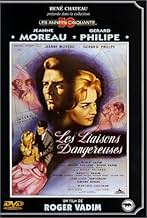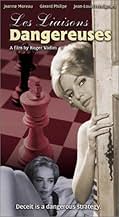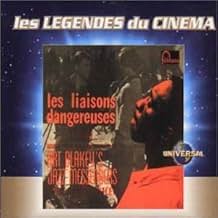Les liaisons dangereuses
- 1959
- 1h 51min
NOTE IMDb
6,8/10
1,6 k
MA NOTE
Juliette Merteuil et Valmont forment un couple raffiné, toujours à la recherche de plaisir et de sensations fortes. Les deux ont des relations sexuelles avec d'autres et partagent leurs expé... Tout lireJuliette Merteuil et Valmont forment un couple raffiné, toujours à la recherche de plaisir et de sensations fortes. Les deux ont des relations sexuelles avec d'autres et partagent leurs expériences les uns avec les autres.Juliette Merteuil et Valmont forment un couple raffiné, toujours à la recherche de plaisir et de sensations fortes. Les deux ont des relations sexuelles avec d'autres et partagent leurs expériences les uns avec les autres.
- Réalisation
- Scénario
- Casting principal
Annette Stroyberg
- Marianne Tourvel
- (as Annette Vadim)
James Campbell
- Petit rôle
- (non crédité)
Michel Dacquin
- Un invité des Valmont
- (non crédité)
Guy Henry
- Un inspecteur
- (non crédité)
Jacques Hilling
- Un invité des Valmont
- (non crédité)
Avis à la une
Many of the reviews here included are as good as anyone needs. Therefore, I will not waste your time, nor mine, writing a subjective take on what is a 6 to 8 point movie.
What compels me to write, however, is a correction: the music was not written by Thelonious Monk, as is stated in at least two reviews. The credit goes to pianist Duke Jordan (1922-2006), contemporary and friend of Charlie Parker, except of course, that Jordan lived a much longer life, the last 25+ years (since 1978) in Denmark.
For those who are interested, the full line up in the soundtrack includes: Sonny Cohn trumpet, Charlie Rouse tenor sax, Eddie Kahn bass, and Art Taylor drums. And, if you excuse a bit of trivia: Duke was married with jazz singer Sheila Jordan from 1952 to 1962 (at this writing, Ms Jordan is 89 years old and still performing!).
Concluding, this movie has arguably one of the best jazz soundtracks of the time, not an uncommon event in French film during the 1950s and 1960s (e.g., Miles Davis, Art Blakey). This cool, post-bop, hard bop era was a great creative time for jazz, no doubt. Memorable and rewarded by time till this day.
Among all Vadim's duds,"les liaisons dangereuses " seems to have stood the test of time better than the other "works" of the director.The reason is to be found in the cast.Gérard Philipe -though largely overshadowed by John Malkovich in Frears's version -and mainly Jeanne Moreau are earnest thespians and you cannot be wrong with them.And Roger Vailland and Claude Brulé had a good idea for the conclusion:fire instead of smallpox allows us to hear Laclos's immortal line "She's wearing her soul on her face!"
Objections to this early version -to be followed by half a dozen of them- remain:that the story should have been transferred to the sixties is eminently questionable:La Merteuil was a definitely modern original character in Choderlos de Laclos's times ;in 1960,such a woman's behavior had become banal.Vadim would do worse when he would transfer Zola's "la curée" to his era.
Proof positive that all that glittered in the nouvelle vague was not gold.
Objections to this early version -to be followed by half a dozen of them- remain:that the story should have been transferred to the sixties is eminently questionable:La Merteuil was a definitely modern original character in Choderlos de Laclos's times ;in 1960,such a woman's behavior had become banal.Vadim would do worse when he would transfer Zola's "la curée" to his era.
Proof positive that all that glittered in the nouvelle vague was not gold.
Interesting adaptation of the infamous Laclos classic, this movie was banned in England on it's original release. Difficult to understand why by today's standards. The movie is introduced by director Roger Vadim who basically warns that everyone is going to be bad, bad, bad. He then appears to head off to the nearest cafe for a nasty cigarette and a vile cup of coffee. Given that the movie was made a decade before the sexual revolution of the 1970's it must have had an aura of scandal about it at the time but is strictly tied to the 1950's and suffers from the inhibitions of the period. Very French, very stylish and well acted by the principals the storyline holds up but the cynicism and callousness of the original book are missing. Still, it's never boring and worth seeing for the performances and the direction that later, more explicit movies would take.
This is one of the movies (not many) where the remake "Dangerous Liaisons" of Stephen Frears wins by a large margin.
First of all those movie had one Great Actress in Jeanne Moreau. Bur ir as an incompetent Director in Roger VAdim and some miscasts like Gérard Philippe as Valmont. Perhaps the main culprit is "Roger Vailland". I'm am very fond of "Vailland",love is novels (namely "Drôle de Jeu", but I've read them when I was too young. Nowadays I believe that is is the wrong kind of scriptwriter. Also Roger Vadim did not care for literature. Ask Brigite Bardot. This is a semi-failure. See it only id you are a fan of Jeanne Moreau. There is more eroticism in "Journal d'une Femme de Chambre" by Luis Buñuel than here, about "boudain". "morcilla" or just plain English "sausage". The Anglo-Saxons cannot make sausages and the current laws forbid to to it properly..
First of all those movie had one Great Actress in Jeanne Moreau. Bur ir as an incompetent Director in Roger VAdim and some miscasts like Gérard Philippe as Valmont. Perhaps the main culprit is "Roger Vailland". I'm am very fond of "Vailland",love is novels (namely "Drôle de Jeu", but I've read them when I was too young. Nowadays I believe that is is the wrong kind of scriptwriter. Also Roger Vadim did not care for literature. Ask Brigite Bardot. This is a semi-failure. See it only id you are a fan of Jeanne Moreau. There is more eroticism in "Journal d'une Femme de Chambre" by Luis Buñuel than here, about "boudain". "morcilla" or just plain English "sausage". The Anglo-Saxons cannot make sausages and the current laws forbid to to it properly..
Roger Vadim's reputation as a director of erotica and his own affairs with numerous leading ladies has denied him serious attention by movie critics. Nevertheless, he did make a few prestigious efforts – mainly adaptations of famous, sometimes infamous, material: the film under review (based on the novel by Choderlos de Laclos), BLOOD AND ROSES (1960; Sheridan LeFanu's "Carmilla"), VICE AND VIRTUE (1963; inspired by the works of the Marquis de Sade), CIRCLE OF LOVE (1964; Arthur Schnitzler's "La Ronde"), THE GAME IS OVER (1966; Emile Zola's "La Curee'") and the "Metzengerstein" segment from SPIRITS OF THE DEAD (1968; based on an Edgar Allan Poe short story). I own all six of these but have watched only four so far, including LIAISONS; actually, I liked all of them – but, excluding SPIRITS, this first rendition of a scandalous classic emerges as not just the most satisfactory of the lot but perhaps the most significant in his entire oeuvre.
Incidentally, in view of the updating of the narrative from the 18th to the 20th century, the full original title is LES LIAISONS DANGEREUSES 1960; tragically, co-star Gerard Philipe would not live to see that year through, as he succumbed to cancer two months after the film's September release though he had, by then, finished work on another, namely Luis Bunuel's REPUBLIC OF SIN (1959). The source novel has been regularly adapted for both the big and small screens, especially in the last 25 years: I had earlier watched the 1988 DANGEROUS LIAISONS and the 1999 modernization CRUEL INTENTIONS, and also own the 1989 VALMONT and the 2003 DANGEROUS LIAISONS TV mini-series (coincidentally, featuring one of Vadim's former flames and VICE AND VIRTUE co-star Catherine Deneuve); speaking of Philipe, Vadim and remakes, it is interesting to note that Philipe had appeared in the original versions of two films Vadim would eventually rework, i.e. LA RONDE (1950) and THE SEVEN DEADLY SINS (1952; Vadim's would be made 10 years later where, again, he was just one of several directors involved in an anthology).
Anyway, this adaptation of French sexual intrigues makes a rather uneasy stab at equating what can be described as the perversions of the nobility (taking pleasure in corrupting the inexperienced, consequently quashing their idealized notion of love) with the amoral attitudes of the late 1950s; I say uneasy because, even if Federico Fellini's contemporaneous LA DOLCE VITA depicted a similarly decaying aristocracy, the 1960s would soon reveal that hedonism was pervasive and not tied to a certain class! That said, the plot retains its essential fascination – aided by the spot-on casting of Philippe, Jeanne Moreau (who would break out internationally soon after), Annette Stroyberg (then Vadim's wife and billed under his surname), Jeanne Valerie and Jean-Louis Trintignant; in keeping with the director's penchant for nudity, all three females mentioned shed their clothes throughout – but these scenes are extremely tame by the standards of even a decade down the line!
There are other good and not-so-good points: on the one hand, the ironic come-uppance of the central conniving pair (Philippe is killed in a fall while struggling with the otherwise mild-mannered Trintignant, after the latter finds out that the former has impregnated his girlfriend – and Philipe's own cousin! – Valerie; Moreau – Philipe's wife, who had also callously tried to break up the young couple's affair by seducing Trintignant – is facially-scarred after being engulfed in flames while trying to dispose of incriminating letters prior to the impending inquest over her husband's death); and the jazz soundtrack by Thelonious Monk (a trend popularized by Miles Davis' score for Louis Malle's LIFT TO THE SCAFFOLD {1958}, also featuring Moreau). On the other hand, some of the dancing at the climactic party is 'wildly' dated but, more importantly, Stroyberg's descent into madness at Philipe's deception simply does not ring true in a modern context! For what it is worth, the film is also included in the "Wonders In The Dark" poll and I watched it appositely to mark the birthdays of its director and main female star.
Incidentally, in view of the updating of the narrative from the 18th to the 20th century, the full original title is LES LIAISONS DANGEREUSES 1960; tragically, co-star Gerard Philipe would not live to see that year through, as he succumbed to cancer two months after the film's September release though he had, by then, finished work on another, namely Luis Bunuel's REPUBLIC OF SIN (1959). The source novel has been regularly adapted for both the big and small screens, especially in the last 25 years: I had earlier watched the 1988 DANGEROUS LIAISONS and the 1999 modernization CRUEL INTENTIONS, and also own the 1989 VALMONT and the 2003 DANGEROUS LIAISONS TV mini-series (coincidentally, featuring one of Vadim's former flames and VICE AND VIRTUE co-star Catherine Deneuve); speaking of Philipe, Vadim and remakes, it is interesting to note that Philipe had appeared in the original versions of two films Vadim would eventually rework, i.e. LA RONDE (1950) and THE SEVEN DEADLY SINS (1952; Vadim's would be made 10 years later where, again, he was just one of several directors involved in an anthology).
Anyway, this adaptation of French sexual intrigues makes a rather uneasy stab at equating what can be described as the perversions of the nobility (taking pleasure in corrupting the inexperienced, consequently quashing their idealized notion of love) with the amoral attitudes of the late 1950s; I say uneasy because, even if Federico Fellini's contemporaneous LA DOLCE VITA depicted a similarly decaying aristocracy, the 1960s would soon reveal that hedonism was pervasive and not tied to a certain class! That said, the plot retains its essential fascination – aided by the spot-on casting of Philippe, Jeanne Moreau (who would break out internationally soon after), Annette Stroyberg (then Vadim's wife and billed under his surname), Jeanne Valerie and Jean-Louis Trintignant; in keeping with the director's penchant for nudity, all three females mentioned shed their clothes throughout – but these scenes are extremely tame by the standards of even a decade down the line!
There are other good and not-so-good points: on the one hand, the ironic come-uppance of the central conniving pair (Philippe is killed in a fall while struggling with the otherwise mild-mannered Trintignant, after the latter finds out that the former has impregnated his girlfriend – and Philipe's own cousin! – Valerie; Moreau – Philipe's wife, who had also callously tried to break up the young couple's affair by seducing Trintignant – is facially-scarred after being engulfed in flames while trying to dispose of incriminating letters prior to the impending inquest over her husband's death); and the jazz soundtrack by Thelonious Monk (a trend popularized by Miles Davis' score for Louis Malle's LIFT TO THE SCAFFOLD {1958}, also featuring Moreau). On the other hand, some of the dancing at the climactic party is 'wildly' dated but, more importantly, Stroyberg's descent into madness at Philipe's deception simply does not ring true in a modern context! For what it is worth, the film is also included in the "Wonders In The Dark" poll and I watched it appositely to mark the birthdays of its director and main female star.
Le saviez-vous
- AnecdotesThe film was released eight weeks before Gerard Philippe's sudden death.
- ConnexionsFeatured in L'amour dure trois ans (2011)
Meilleurs choix
Connectez-vous pour évaluer et suivre la liste de favoris afin de recevoir des recommandations personnalisées
- How long is Dangerous Liaisons?Alimenté par Alexa
Détails
- Durée
- 1h 51min(111 min)
- Couleur
- Rapport de forme
- 1.37 : 1
- 1.66 : 1
Contribuer à cette page
Suggérer une modification ou ajouter du contenu manquant
































